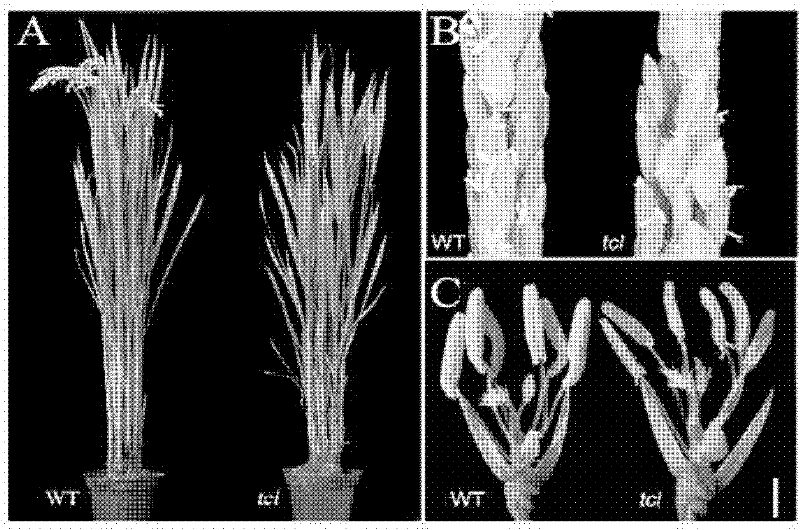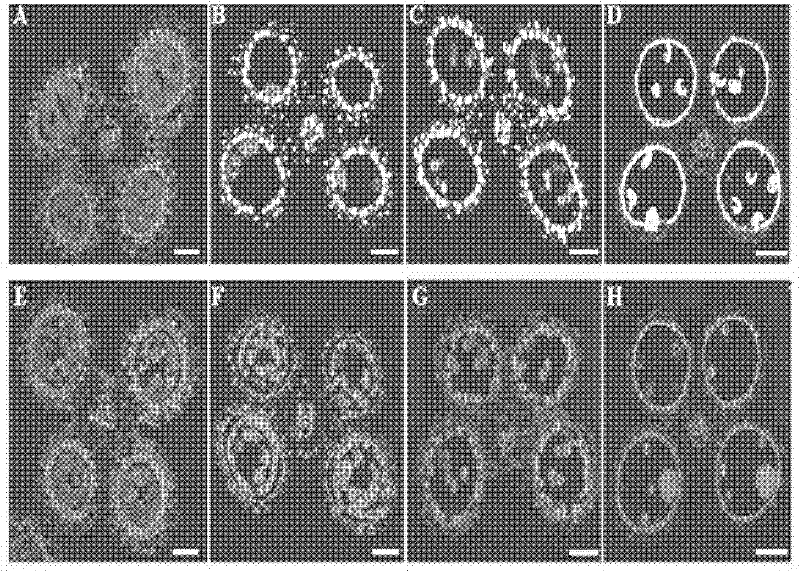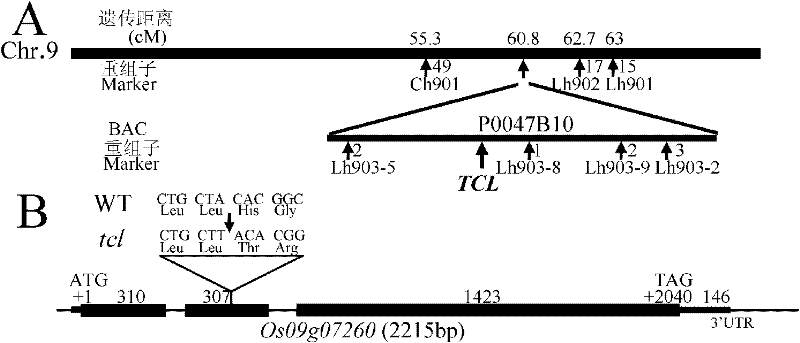Application of a vector with male-sterile gene TCL
A male sterility gene and carrier technology, applied in application, genetic engineering, plant genetic improvement and other directions, can solve the problems of unclear molecular regulation mechanism and network of pollen outer wall components
- Summary
- Abstract
- Description
- Claims
- Application Information
AI Technical Summary
Problems solved by technology
Method used
Image
Examples
Embodiment 1
[0035] Obtaining and Morphological Observation of tcl Mutant Plants
[0036] use 60 The seeds of japonica rice 9522 were mutagenized by Coγ-rays at a dose of 280Gy, and mutants were obtained. A male sterile mutant in the mutagenized F2 generation was backcrossed for three generations, and a stable genetic mutant tcl regulated by a recessive single gene was obtained. All plant materials were planted at the experimental base of Shanghai Academy of Agricultural Sciences. The tcl mutant was backcrossed with japonica rice 9522, all the F1 generations were fertile, and segregation occurred in the self-crossed F2 generation, including 189 normal plants and 55(χ 2 =0.65), indicating that the phenotype of the male sterile mutant was caused by a single nuclear gene mutation. Morphological observation of tcl mutant plants. Such as figure 1 , the phenotypic comparison between wild type and mutant tcl shows that the spikelets of the wild type droop after fruiting (left), while the tcl...
Embodiment 2
[0038] Programmed death signal detection in anther tapetum cells of tcl mutants
[0039] Step 1, preparation of paraffin sections of wild-type and mutant tcl anthers at various developmental stages
[0040] (1) Take an appropriate amount of required materials (not exceeding 1 / 20 of the volume of the fixative solution) into a penicillin vial filled with FAA fixative solution. Use a vacuum pump to slowly pump air (10 minutes for the pumping process), place it in a vacuum state (>20atm) for 15 minutes, and then slowly deflate (10 minutes for the deflation process). Air bubbles can be observed, and the sample sinks to the bottom of the bottle. Store at 4°C;
[0041] (2) Dehydration; the gradients are: 50% ethanol (the plant tissue sinking at the bottom of the bottle indicates that the pumping is sufficient), 50% ethanol, 60% ethanol, 70% ethanol, 85% ethanol, 95% ethanol, 100% ethanol , 100% ethanol, 1 / 4 xylene 3 / 4 ethanol, 1 / 2 xylene 1 / 2 ethanol, 3 / 4 xylene 1 / 4 ethanol, 30 minu...
Embodiment 3
[0074] Location and cloning of TCL gene
[0075] Step 1, positioning the population, crossing tcl with the indica rice line Longtefu B, selfing to obtain the F2 generation, and selecting male sterile plants among them as the positioning population;
[0076] Step two, rice DNA extraction. The improved CTAB method is used for extraction, including the following steps: take 0.1-0.2 grams (about half a piece) of leaves and put them in a small mortar, add an appropriate amount of liquid nitrogen, grind them to powder immediately, put them into a 2ml centrifuge tube, add 700ul 100℃ Put the preheated 1.5xCTAB solution in a centrifuge tube, mix it carefully, put it in a 56°C water bath, take out the centrifuge tube after 20 minutes, add an equal volume of chloroform / isoamyl alcohol, mix vigorously, centrifuge at 13000rpm for 10 minutes, and take the supernatant in In a new tube, add 900ul of absolute ethanol and mix well, then put it at -20°C for more than half an hour. The precipit...
PUM
 Login to View More
Login to View More Abstract
Description
Claims
Application Information
 Login to View More
Login to View More - Generate Ideas
- Intellectual Property
- Life Sciences
- Materials
- Tech Scout
- Unparalleled Data Quality
- Higher Quality Content
- 60% Fewer Hallucinations
Browse by: Latest US Patents, China's latest patents, Technical Efficacy Thesaurus, Application Domain, Technology Topic, Popular Technical Reports.
© 2025 PatSnap. All rights reserved.Legal|Privacy policy|Modern Slavery Act Transparency Statement|Sitemap|About US| Contact US: help@patsnap.com



